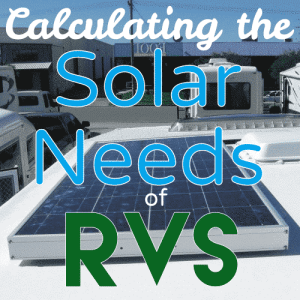 One thing many full time RVers like to do is take advantage of free stuff. Whether it is boondocking at their ideal hidden oasis, or finding a deal on the latest RV gadget. That holds true for energy as well. Because, as any RVer knows, power (lights, appliances, electronics) is one of those things you can’t do without.
One thing many full time RVers like to do is take advantage of free stuff. Whether it is boondocking at their ideal hidden oasis, or finding a deal on the latest RV gadget. That holds true for energy as well. Because, as any RVer knows, power (lights, appliances, electronics) is one of those things you can’t do without.
But most RVers also know that, despite the benefits of having onboard power (via your 12-volt power system) is much more handy than having to plug into the grid, sometimes shore power isn’t always available.
That’s where solar power comes in. With the right number of solar panels, combined with voltage regulators and a bank of the right type of batteries (along with voltage inverters as needed), you can live quite a long time off the grid and still be comfortable.
The first question everyone always asks is “how many panels and batteries do I need to be able to live the way I do if I do happen to go off-grid?”
This article is written to help you get started in figuring out what you need.
What is an RV Solar system comprised of?
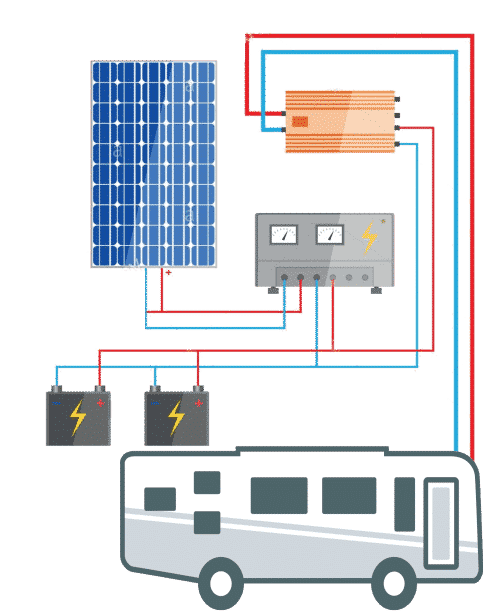 There are 4 basic components to any RV solar system: The solar panel(s), a charge controller, a battery (or bank of batteries), and a power inverter. If you are in an RV the power inverter may or may not be required.
There are 4 basic components to any RV solar system: The solar panel(s), a charge controller, a battery (or bank of batteries), and a power inverter. If you are in an RV the power inverter may or may not be required.
- Solar Panel – Solar panels (also known as “PV panels”) are used to convert light from the sun, which is composed of particles of energy called “photons”, into electricity that can be used to power electrical loads. Solar panels are constructed of several individual solar cells which are themselves composed of layers of silicon, phosphorous (which provides the negative charge), and boron (which provides the positive charge). Solar panels absorb the photons and in doing so initiate an electric current.
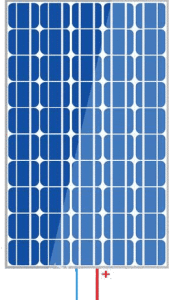
- Charge Controller – A charge controller or charge regulator is essentially a voltage and/or current regulator to keep your RVs batteries from overcharging. It regulates the voltage and current coming from the solar panel(s) before sending it to the battery. Most “12 volt” solar panels actually put out about 16 to 20 volts, so if there is no regulation the batteries will be damaged from overcharging. Most batteries need around 14 to 14.5 volts to get fully charged.
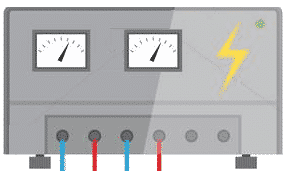
- Batteries – Batteries are used to store the power. Your RV likely already has some batteries which are designed to store power to use “off-grid”. They generally can’t provide consistent long-term power, especially if you only have a single battery. That’s why you need to have multiple batteries, connected in series, to provide sustainable long-term power.
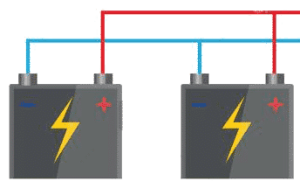
- Power Inverter – A power inverter is used to convert the 12-volt power stored in your battery bank into usable 120 volt power for your devices. There are 3 types of power inverters – Square sine wave, pure sine wave, and modified sine wave inverters. Most of your RV will run off of modified sine inverters, but many modern electronics, including TVs and computers should be run off pure sine wave inverters. Some RVs come with inverters already installed to run most of our RV equipment, but you may need to install a pure sine wave inverter to handle your more sensitive electronics.

Watts, Amps, Voltages – What does it all mean?
One of the first things you need to understand is your own usage. How much power do YOU use on a daily or weekly basis. From there, you can figure out the rest of the system.
Power consumption is recorded in Watts. For instance, there are 16 W, 60 W and 100 W light bulbs. The higher the rating, the more energy it consumes. If you have a 100 W light bulb turned on for 1 hour, it will consume 0.1 kWH (kilowatt-hours):
100 W x 1 Hour / (1000 W / 1 kW) = 0.1 kWH
Understanding how Batteries Work
Your typical RV runs off of 12 Volts DC power. It may be powered by one (or many) 12 V batteries, or pairs of 6 V batteries wired to produce the required 12V output. The number of batteries you have in your rig will likely be different than others depending on your RVs configuration. Battery capacity is measured in Amp Hours (i.e. 20 Ah)
A 20 Ah battery will output the following power:
20 Ah x 12 V = 240 Wh
Lead acid batteries only have an 85% charge efficiency. What this means is that from ever 1 amp sent to a lead acid battery bank only 0.85 amps are stored for use. Therefore, we’ll need to divide the wattage by 1.15 to get a truer idea of how much our battery will store:
240 / 1.15 = 208.69
Since we already know that Volts x amps = watts, we now know that the above 20 AH battery (which produces just over 200 Wh capacity) can be used in different ways that always add up to 200 Wh such as:
200 W for 1 hour or
100 W for 2 hours or
50 W for 4 hours.
How long will this be able to run the 100 W light bulb? Taking into account the loss of energy through the DC/AC inverter (we assume than an inverter is 96% efficient), this battery could run a 100 W light bulb for:
200 WH / 0.1 kWH * 96% = approx. 1.9 hours
That means that 1 20 AH battery will power a single 100 W light bulb for about 2 hours before it will need to be charged. It has enough power stored to provide 100 watts of light for 2 hours.
How much energy will a solar panel generate?
The power rating on solar panels is provided in Watts and gives the maximum amount of power a solar panel will generate in bright sunlight. To calculate the amount of power a solar panel can provide to the battery, we multiply:
(the rated power of the solar panel)
x
(the number of hours of direct sunlight)
x
(an estimated percentage of time it will receive direct sunlight (no clouds))
x
(the efficiency of the charge controller)
So, if we had a solar panel rated at 80 watts, and we assume 5 hours of sunlight in a day, with about 75% of the day having no clouds, and a charge controller efficiency of 85% we would get:
80 W x 5 hours x 75% no clouds x 85%
= 255 Wh
That means that our single 80 watt panel will generate 255 Wh. This is more than the 240 Wh capacity of the battery, therefore it will keep this battery fully charged.
It’s important to note that this is a fairly conservative calculation – only assuming 5 hours of direct sunlight every day. Solar panels still generate current even on cloudy days. Just not at its peak rate.
We should also note that an 85% efficiency for the charge controller is typical. You should look for one that is smart enough to disconnect the battery from the panel once it is fully charged so that it doesn’t overcharge the battery leading to damage to the electrolytes or posts.
Step 1: Calculate your usage
The first thing you need to do is compose an inventory of all items you own that use electricity. This includes not only any electric appliances you have packed into your RV (like toasters, coffee makers, hair dryers, etc.) but also any appliances that were already installed, such as your refrigerator, electric fireplace (if installed) washer/dryer etc.
Be sure to take your time and go through your RV thoroughly until you have identified all the electric appliances you may need.
Next, calculate how many watts or amps each device draws. It will be best to try and convert everything to watts so you can get a proper calculation. To convert amps to watts it’s a simple formula:
Volts x amps = watts
Or
Watts / Volts = amps
That means that if your toaster draws 5 amps (for example) your toaster draws:
120 V x 5 amps = 600 watts.
Keep in mind that while you have EVERYTHING electric listed, you do not use them all at once, but it is nice to have an idea of how much your total power consumption would be.
So let’s say that in a day, we do use some lights. We watch TV for 4 hours per day, and spend 5 hours per day cooking. We use our electric fireplace for a couple hours at night for heat, but our laptops are on for 12 hours per day. We also have some miscellaneous things that happen through the day such as – using a toaster, making a cup of coffee, or asking our Google Home what the weather will be like today). These miscellaneous things use 2 amps on average.
To calculate your usage, create a table like this:
| Device | Amps | Hours | Amp Hours |
|---|---|---|---|
| Lights | 1 | 10 | 10 |
| TV | 4 | 4 | 16 |
| Cooking | 12 | 5 | 6 |
| Electric Fireplace | 7.5 | 2 | 15 |
| Laptop | 10 | 12 | 120 |
| Other | 2 | 12 | 24 |
Our total needs for the day are:
10 + 16 + 6 + 15 + 120 + 24 = 191 Ah (Amp Hours)
Step 2: Figuring Out How Many Batteries We Need
If you are OK up until now, then you should have an idea of how much power you need, and what your solar capacity requirements are. Now we need to figure out how many batteries you need to store that power.
As mentioned above, traditional lead acid batteries are about 85% efficient.
Another assumption we have to make is that not every day will be sunny like in our earlier calculations. So let’s assume we only have sun for 4 days per week, giving us 3 cloudy days.
We know our total needs for the day are:
10 + 16 + 6 + 15 + 120 + 24 = 191 Ah (Amp Hours)
And if we want our batteries to be able to handle the load for 3 days (assuming 3 full days with no sun) then:
191 Ah x 3 = 573 Ah
However, Since the allowable depth of discharge of a typical lead acid battery is only 50% we have to double the usable amp-hour capacity required to find the rated amp-hour capacity required.
573 Ah x 2 = 1146 Ah
We need to have a total capacity of 1146 Ah. Using this number, we can figure out how many batteries we need based on the actual rating found on the battery.
So let’s assume we are running 200 Ah batteries: 1146 / 200 = approximately 6. In other words we will need approximately 6 200 Ah batteries to store all the juice we may need.
Step 3: Putting it all together
Let’s assume you have followed all the steps above. You have your power inventory and know how much you need capacity for. Keep in mind that you won’t be using all your electrical appliances at once, so try and make an educated guess as to what you will use all day, and which electrical items are only used for a shorter period.
For example, your RV fridge, if running on electricity, will not run all day. It will turn on and off as needed. Similarly, if you use a toaster oven, or an electric fireplace, you usually only use those for a few hours at a time. However if your RV is like ours, the TV is on most of the day, so you need to account for that.
Once you’ve figured out your actual requirements, figure out what you need.
Let’s use the calculations we figured out earlier: We need 191 Ah over a 12 hour day:
191 Ah / 10 hours = 19.1 Amps
Since we know that Amps x Volts = Watts, so we need:
19.1 x 12 = 229 watts
Which means our single 80 watt solar panel will not generate enough power in one hour to power our needs. We will need at least 4 (4 x 80 = 240 watts) solar panels to cover our usage.
So based on our calculations we will need to have 4 80 watt solar panels to generate the 240 watts of power we need, coupled with 6 200 Ah batteries to store all our energy.
This should provide us more than enough power to keep all our devices running, whether we are plugged into shore power or not, and whether it’s a cloudy day or sunny day.






